The fundamentals keeping chips hot

Global X ETFs
Semiconductors, or microchips, are like the brains that enable electronic devices – from televisions to phones and computers – to function. They are so ubiquitous that we can just forget they are there.
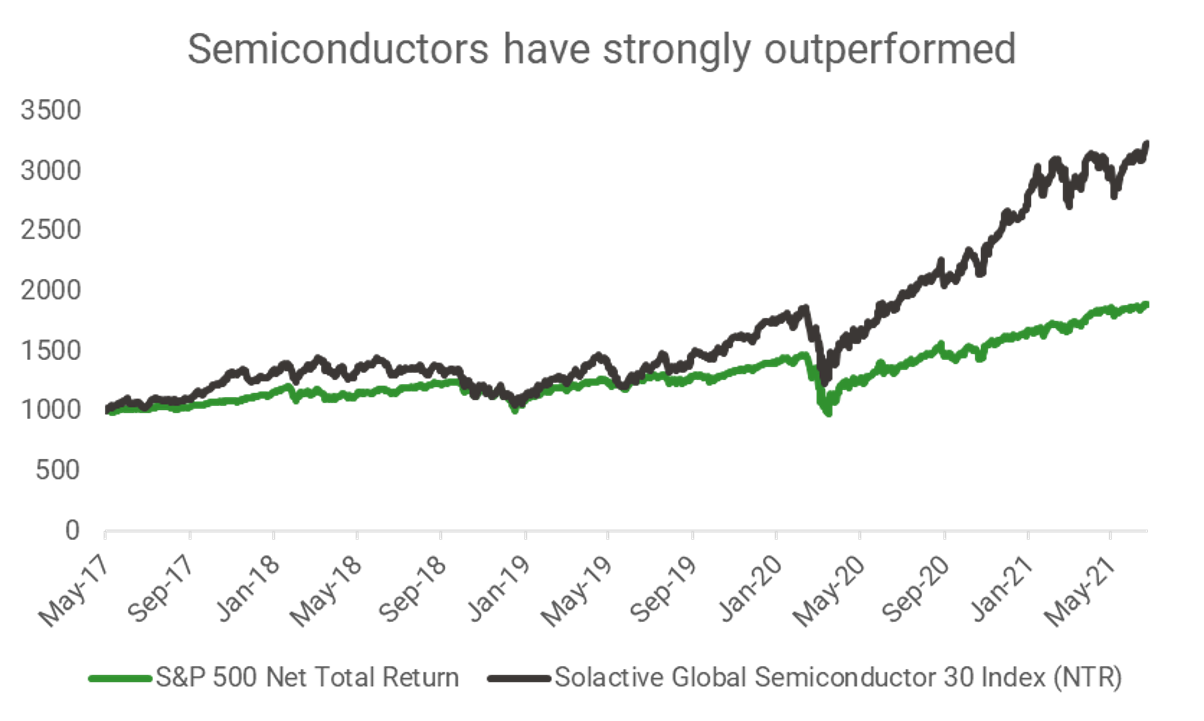
Source: Solactive, 14 July 2021
However, the ongoing semiconductor shortage, which has increased wait times for some semiconductors to 18 weeks as of June 2021 according to Bloomberg (1), has raised the visibility of this crucial sector.
Strong sales growth, supported by megatrends
Semiconductors are at the heart of future technology. Megatrends – such as electric vehicles, smart factories, the internet of things – all require semiconductors to operate. In many cases, advancements in technology have only been possible due to improvements in semiconductors.
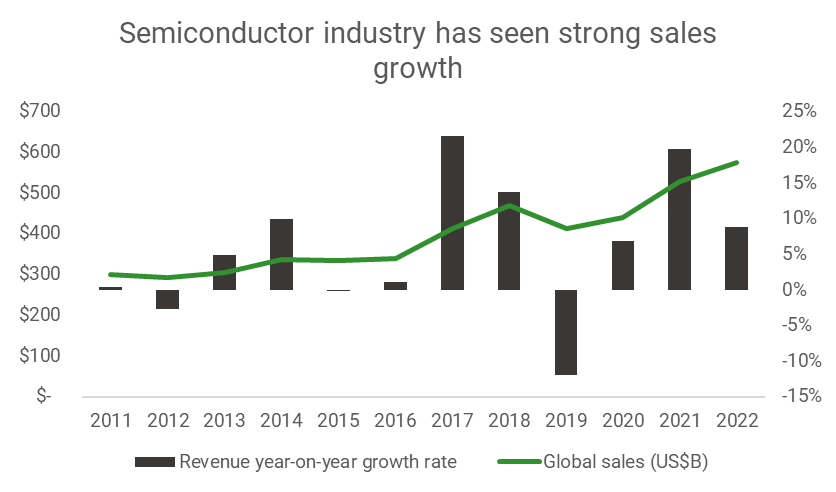
Source: Thomas Alsop, Statista, 12 July 2021
Their central role in technology has meant industry revenue (pictured above) grew at a rate above GDP growth well before the pandemic, despite the dip in 2019 caused by the Trump trade war. And is forecast by PwC to grow at a CAGR of 8.6% right the way to 2028.
There are several exciting future trends driving semiconductors. They include:
- Electric and self-driving cars
- Cryptocurrency (semiconductors are used for crypto mining)
- Artificial intelligence, as it requires graphic processing units or the newer AI chips
- Video games and cloud computing, given their use in consoles and servers
The latter three areas – AI, cloud computing, eSports – are experiencing strong growth, and taking semiconductors with them.
But electric and self-driving cars are perhaps the most exciting.
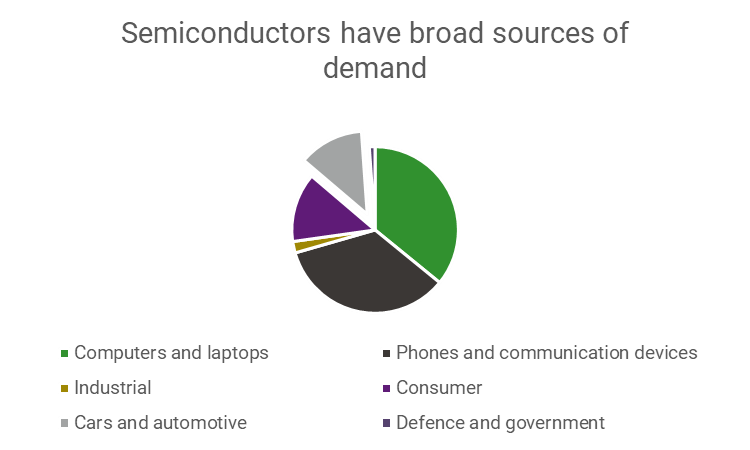
Source: Source: World Semiconductor Trade Statistics, 12 July 2021
Cars currently make up 10% of the overall demand for semiconductors, data from World Semiconductor Trade Statistics (2020) indicates.
While substantive, this is still small. But the electric vehicle market is forecast to grow at an impressive 25-40% a year this decade, as the world rides out to meet the challenges of global warming.
And electric vehicles need far more semiconductors than petrol-guzzling cars. This is reflected by the rising cost of electronics as a percentage of total car cost (below), which is projected to rise to almost 50% by 2030.
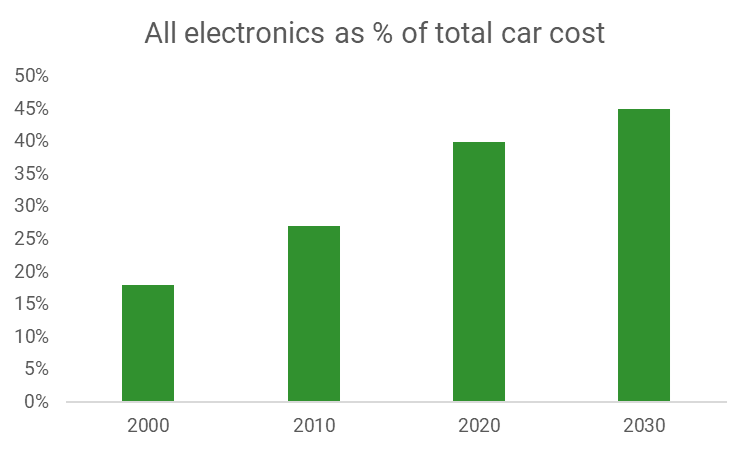
Source: IHS, Deloitte analysis, 1 July 2021
High barriers to entry and R&D spend
Semiconductor businesses are protected by high barriers to entry. The industry is extremely capital intensive, with factories usually costing billions of dollars to build, often taking several years to complete.
TSMC and Samsung, the two largest factory businesses, have committed to spend over US$100 billion this decade to make their factories larger and more efficient.
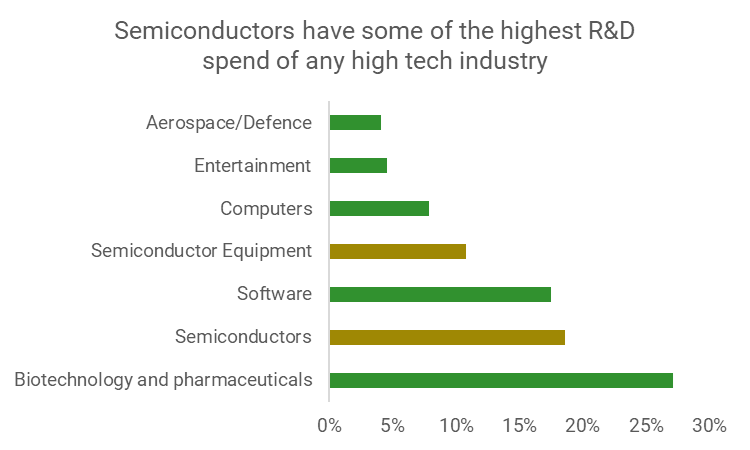
Source: Source: Aswath Damodaran, NYU, 12 July 2021
The capital intensity means oligopolies or monopolies dominate every point in the supply chain, and not just factories.
ASML, the Dutch giant, monopolises lithography machines, which ‘prints’ microchip designs onto the silicon wafers. Nvidia, Intel and AMD have close to 100% market share for graphics processing units in personal computers.
Reinforcing these barriers to entry are high research and development costs, which also help ensure that the industry continues evolving.
According to NYU professor, Aswath Damodaran, semiconductor designers like Nvidia, AMD and Broadcom, have the second-highest level of R&D spending of any of the high-tech industries, behind only biotech and pharmaceuticals.
While semiconductor equipment companies, which create the machines used to build semiconductors, like Lam Research and Applied Materials come in fourth.
Valuation: Are semiconductors expensive?
With the strong rally that semiconductors have enjoyed the past few years, the question obviously arises whether semiconductors are expensive or overvalued.
Questions of valuation are particularly acute with semiconductors as they were some of the worst offenders during the dot-com bubble.
Investors are certainly wise to be cautious—fool me once shame on you, fool me twice shame on me. Nonetheless, in our view, there are some crucial differences between the semiconductor businesses of today, and in the late 1990s.
Semiconductors have stronger fundamentals and justifiable valuations. Industry revenue and earnings are far larger in 2021 than in 1999. The valuations that the major players are trading on, such as price to earnings and price to sales, are much lower.
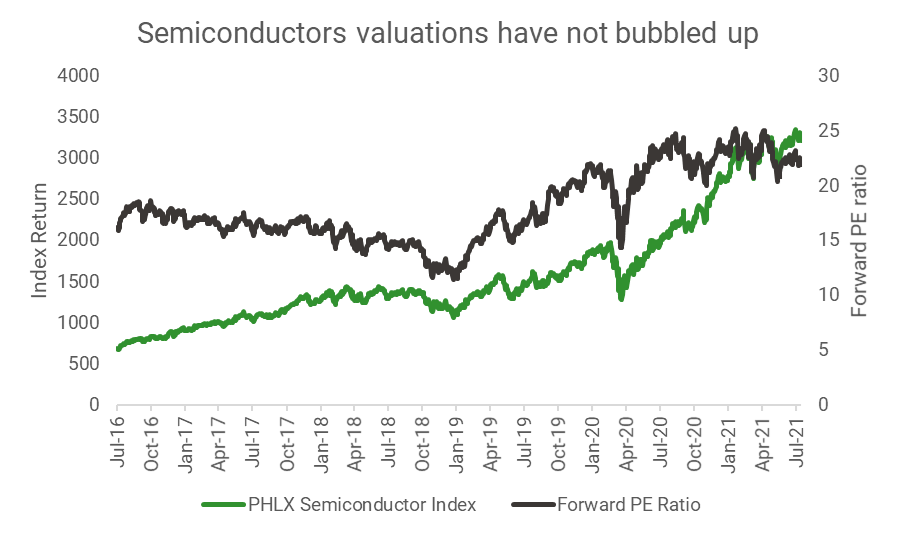
Source: Bloomberg, 16 July 2021
More government support. Semiconductor companies are enjoying more government subsidy than ever before. The US senate recently approved a $250 billion tech stimulus package, which included substantial subsidies for chipmakers.
Interest rates are lower. Interest rates today are lower than in the late 1990s. Furthermore, they seem set to remain low. These lower rates put a higher premium on growing businesses, due to the way that discount rates compound.
Invest in semiconductors: dip into chips
For investors wanting access to this promising sector, the ETFS Semiconductor ETF (SEMI) provides one solution. SEMI buys the world’s 30 largest semiconductor businesses, spanning from foundries to designers to equipment makers.
The first global semiconductor ETF to list in Australia, SEMI takes a market capitalisation weighted approach. It ensures the top innovators are well represented while capping the biggest stocks at 10%.
Access a range of opportunities
ETF Securities offer a range of ETFs across asset classes, regions, sectors and themes for your investment portfolio. Click the 'CONTACT' button below to get in touch with us.
(1) (VIEW LINK)
1 topic

Expertise

